
 |
Tea Clipper |
 |
| from TeaAntiques.com | ||
| Edition Eighty |
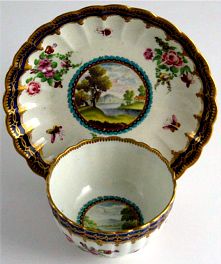
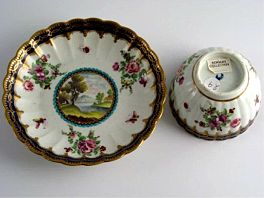
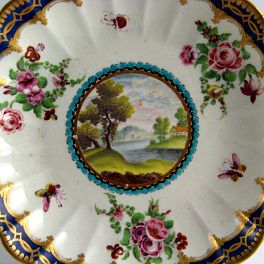
One of the most beautiful tea bowls and saucer that came from the famous Eighteenth century Worcester factory, c 1780 . This stunning tea bowl and saucer is of the fluted shape, exquisitely decorated in the 'Dalhousie' style, this including central cartouches painted with delightful landscapes. This is combined with the very rich decoration of bouquets of flowers interspersed with insects and with blue ground borders richly gilded. A most rare and charming Worcester tea bowl and saucer for the connoisseur collector.
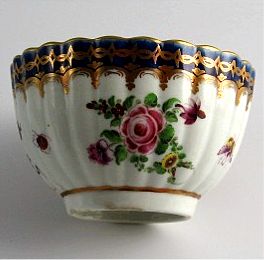
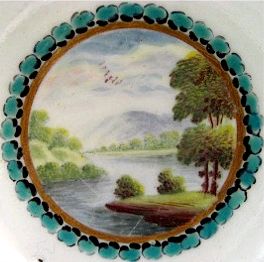
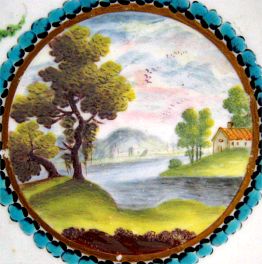
This is a rare and most exquisite tea bowl and saucer, one of the very best with which I have had the privilege to deal. A most rare and charming Worcester tea bowl and saucer c1780, for the connoisseur collector.
More details of this item and other tea related antiques can be found by visiting my web site at www.TeaAntiques.com.

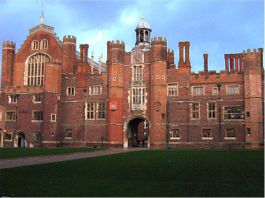 To walk through Hampton Court Palace is to walk through Royal history from
the Tudor time of King Henry VIII to The Hanoverian's, George I and II. Each
Monarch has made their own mark on the layout and style of the Palace, none more
so that Henry VIII who was the first Monarch to turn the place into a Palace,
King William and Queen Mary later planned to demolish the Tudor Palace to build
their own much more up to date and formal Palace. The last major redesign of the
palace was by King George II and Queen Caroline, who fitted out the interior of
the Queen's State Apartments planned for William and Mary, these unfinished due
to the early death of Queen Mary from which time King William lost interest in
continuing the work at Hampton Court.
To walk through Hampton Court Palace is to walk through Royal history from
the Tudor time of King Henry VIII to The Hanoverian's, George I and II. Each
Monarch has made their own mark on the layout and style of the Palace, none more
so that Henry VIII who was the first Monarch to turn the place into a Palace,
King William and Queen Mary later planned to demolish the Tudor Palace to build
their own much more up to date and formal Palace. The last major redesign of the
palace was by King George II and Queen Caroline, who fitted out the interior of
the Queen's State Apartments planned for William and Mary, these unfinished due
to the early death of Queen Mary from which time King William lost interest in
continuing the work at Hampton Court.
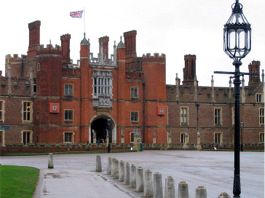
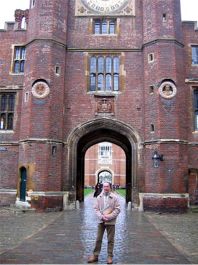
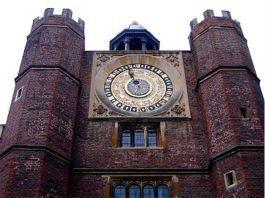
The first view that the visitor gains of the Palace is very much Tudor, with the many varied buildings of red brick, stone framed windows and a varied skyline made up of some turreted roofs and amazingly decorative chimneys.
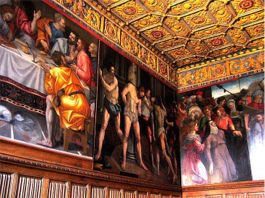 Before becoming a Royal Palace, it had been built by Cardinal Wolsey from
c1514. Wolsey was the Archbishop of York and became a cardinal and Lord
Chancellor in 1515. he was ambitious and set about turning Hampton Court in to
his country retreat. Set upon the banks of the river Thames it afforded good
links with his town life and town house of York Place, Westminster. In 1525 it
was presented to King Henry VIII as a 'gift' after Henry and his then wife
Catherine of Aragon took a liking to the Place. It then consisted of inner and
outer courts, hall, chapel and lodgings as well as some splendid apartments.
Before becoming a Royal Palace, it had been built by Cardinal Wolsey from
c1514. Wolsey was the Archbishop of York and became a cardinal and Lord
Chancellor in 1515. he was ambitious and set about turning Hampton Court in to
his country retreat. Set upon the banks of the river Thames it afforded good
links with his town life and town house of York Place, Westminster. In 1525 it
was presented to King Henry VIII as a 'gift' after Henry and his then wife
Catherine of Aragon took a liking to the Place. It then consisted of inner and
outer courts, hall, chapel and lodgings as well as some splendid apartments.
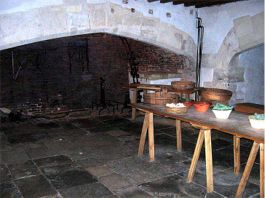
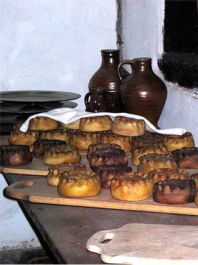 Henry VIII set out to improve the Palace at Hampton Court by demolishing
Wolsey's Great Hall to build an even larger one which he begun in 1532. He also
remodelled the Chapel Royal and added the vast kitchens needed to service the
large number at Court. These kitchens were well laid out so that various tasks
could be performed in separate areas. there were areas for the dairy, fish,
baking, pie making, cellars as well as the main kitchen and servery.
Henry VIII set out to improve the Palace at Hampton Court by demolishing
Wolsey's Great Hall to build an even larger one which he begun in 1532. He also
remodelled the Chapel Royal and added the vast kitchens needed to service the
large number at Court. These kitchens were well laid out so that various tasks
could be performed in separate areas. there were areas for the dairy, fish,
baking, pie making, cellars as well as the main kitchen and servery.
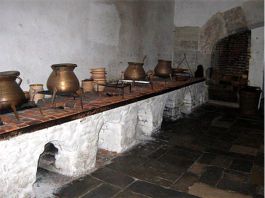
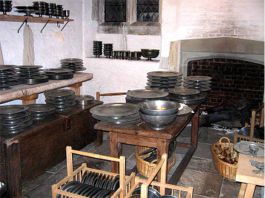
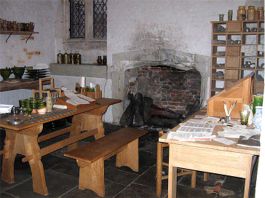
When visiting the Palace, you walk through Wolsey's gate into Base Court and then on through the Clock Tower gate into Clock Court and it is here that you can plan your tour. There are various 'costumed' guided tours of the State Apartments. These tours include, King Henry VIII, King William III and Queen Mary's State Apartments in separately timed tours throughout the day. There are further tours and activities which are presented on a programme upon entry to the Palace. My advice is to take these tours, starting with a tour of King Henry's State Apartments, so that you then work through the history of the Palace in chronological order to build up a picture of how it changed and developed over the years.
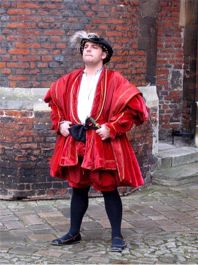
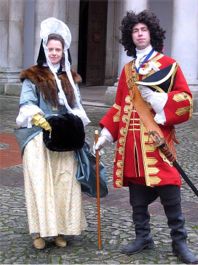
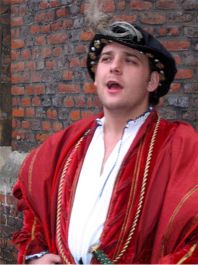 The tour guides are very well appointed in authentic dress and are very
knowledgeable on the period and the Palace. The guides take a character from
history who would have been associated with the monarch at the time. My tour of
the State apartments included Lord Leicester and Catherine Howard, later to be
one of Henry VIII's wives. To a certain extent, the tour is a play between the
guides to get across to the visitor what was going on at that time and is a
light hearted way of learning the history.
The tour guides are very well appointed in authentic dress and are very
knowledgeable on the period and the Palace. The guides take a character from
history who would have been associated with the monarch at the time. My tour of
the State apartments included Lord Leicester and Catherine Howard, later to be
one of Henry VIII's wives. To a certain extent, the tour is a play between the
guides to get across to the visitor what was going on at that time and is a
light hearted way of learning the history.
The tour of Henry VIII's State Apartments includes the Great Hall with its mighty 'hammer beam' roof, and some of Wolsey's rooms. Unfortunately, many of Henry VIII's private apartments were demolished by William and Mary when they set out to improve the Palace. However, the Tudor Kitchens do remain and are worth a visit after the tour of Henry VIII's State Apartments. If you are luck, there are at times demonstrations on Tudor cooking going on in the kitchens.
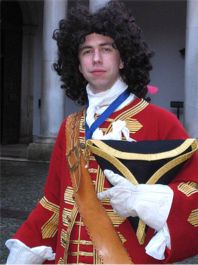 To follow on from Henry VIII's State apartments, take a tour of William III's
State Apartments. For this tour I was guided by a courtier of William and Mary,
resplendently dressed in beautiful red coat with ample gold braid. He also wore a
very fashionable wig, without which I am sure he would not have been allowed to
enter the State Apartments at that time.
To follow on from Henry VIII's State apartments, take a tour of William III's
State Apartments. For this tour I was guided by a courtier of William and Mary,
resplendently dressed in beautiful red coat with ample gold braid. He also wore a
very fashionable wig, without which I am sure he would not have been allowed to
enter the State Apartments at that time.
Not much had happened to Hampton Court from the time of Henry VIII to the time when William and Mary came over from the Netherlands to rule jointly as King and Queen, keeping a protestant faith on the throne. The Stuarts did little in the way of changes to the fabric of the palace, although Charles I did add to the collection of art treasures. Indeed, Charles II hardly spent any of his time at Hampton Court.
William of Orange, Stadtholder of the Netherlands and his wife, Mary, elder daughter of King James II ascended the English throne, at the invitation of the Government, in 1689. William was an asthma sufferer and found the smoke and London fogs worsened his condition, thus decided to make Hampton Court his principle out-of-town residence.
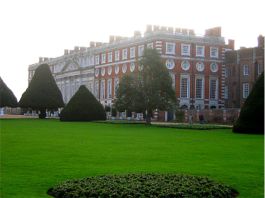
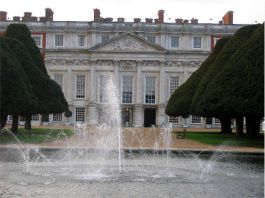
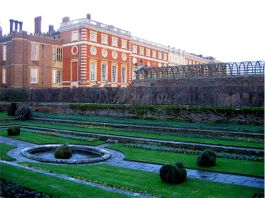
William and Mary liked the location of Hampton Court, reminding them of their native home in the Netherlands, but the Tudor Palace itself was far too old fashioned for their taste and comfort. William engaged Sir Christopher Wren, Surveyor of the Kings Works, to replace the Tudor Palace with something that would rival the spectacular grandeur of the French King Louis XIV's Palace at Versailles, and so he did.
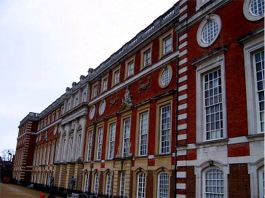 At the subsequent loss of much of the Tudor palace, Sir Christopher Wren
created a beautiful and grand Palace for William and Mary. He demolished the
Tudor buildings around what was Cloister Green Court, replacing it with Fountain
Court around which were the State Apartments for the King and Queen. This
building of London red brick with white stone dressings is immaculate in its
baroque style. By 1693 much of the shell of the building of the New State
apartments was complete. However, in 1694 Queen Mary died from Smallpox,
heart broken, William had work at Hampton Court stopped. It wasn't until his
Palace at Whitehall burned down, that he finally had his State Apartments at
Hampton Court Palace completed. Those of the Queens remained an empty shell.
At the subsequent loss of much of the Tudor palace, Sir Christopher Wren
created a beautiful and grand Palace for William and Mary. He demolished the
Tudor buildings around what was Cloister Green Court, replacing it with Fountain
Court around which were the State Apartments for the King and Queen. This
building of London red brick with white stone dressings is immaculate in its
baroque style. By 1693 much of the shell of the building of the New State
apartments was complete. However, in 1694 Queen Mary died from Smallpox,
heart broken, William had work at Hampton Court stopped. It wasn't until his
Palace at Whitehall burned down, that he finally had his State Apartments at
Hampton Court Palace completed. Those of the Queens remained an empty shell.
The Kings state apartments followed the fashion of the time creating a procession of rooms through which courtiers and visitors would pass depending on rank and status. Many subjects would be lucky to get as close as The Grand Staircase! The first of the rooms after the staircase would have been the most public of rooms. Rooms from this room towards the Kings State Bedroom would get progressively smaller, but more lavish in their decoration. The first room may have a chandelier made from silver, the second of gold the third of rock crystal, thus showing the importance of the room. Beyond the State Bedroom would be the Kings private bedroom in which he would actually sleep. In the morning he would move to the state Bedroom for the public dressing and robing ceremony to take place. Only the highest of the high would be allowed to be in the room to witness this.
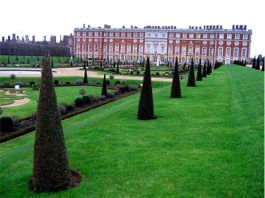
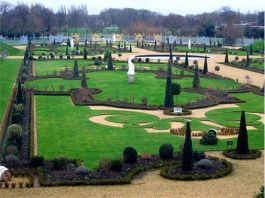
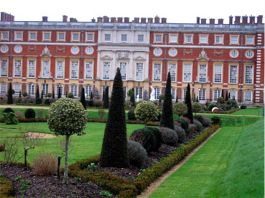
As well as creating the beautiful new Palace buildings, William and Mary were extremely keen on formal gardens. They had the gardens in front of the State apartments designed and laid out in this style. they also grew many rare and exotic species including blackwood cedar, cinnamon and olives.
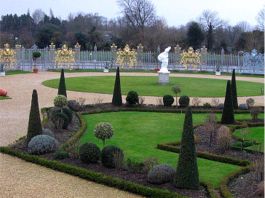
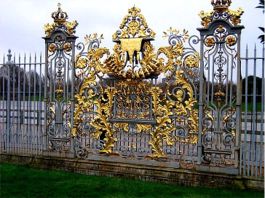 On the South Front of the Palace was the Privy Garden. Today this has been
re-created in its rich formal style with a tapestry of curving flower beds,
these given a formal structure using shaped box, bay and yew hedging, whether
planted in the beds or adorning them in large white tubs. The overall effect is
breathtaking, especially when viewed from the first floor State Apartments, or
from the raised walkways. The garden has at its centre a circular pond and
fountain and at the far end where it meets the 'Long Water', leading towards the
river Thames, some ornate wrought
iron railings and gates. The centre gates are richly gilded that even on a dull day
shine out at you from the Palace. William had to get the level of this garden
taken down by a good three feet, so that is would afford him just a glimpse of
the river from his State Apartments.
On the South Front of the Palace was the Privy Garden. Today this has been
re-created in its rich formal style with a tapestry of curving flower beds,
these given a formal structure using shaped box, bay and yew hedging, whether
planted in the beds or adorning them in large white tubs. The overall effect is
breathtaking, especially when viewed from the first floor State Apartments, or
from the raised walkways. The garden has at its centre a circular pond and
fountain and at the far end where it meets the 'Long Water', leading towards the
river Thames, some ornate wrought
iron railings and gates. The centre gates are richly gilded that even on a dull day
shine out at you from the Palace. William had to get the level of this garden
taken down by a good three feet, so that is would afford him just a glimpse of
the river from his State Apartments.
From the east front of the Palace, along which were intended the Queens State Apartments, again the gardens were laid out in formal fashion, this the Fountain garden has a 'Goose Foot' three path structure away from the palace and half way down the main central path a huge oval pond and fountain. The paths are bounded with lines of enormous mushroomed shaped yew trees.
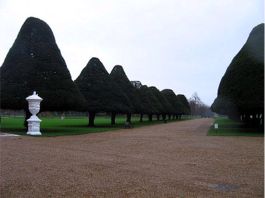
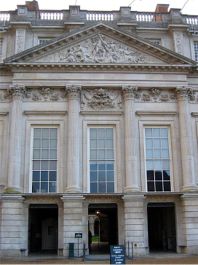
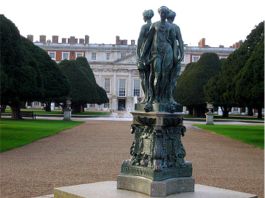
A further set of beautiful small formal gardns are to be located in the triangle of grounds between the Privy Garden and the river Thames. these delightful little compartmented gardens are for much of the year full of colourful annual plants or bulbs. Against the river Thames itself stands William III's Banqueting House.
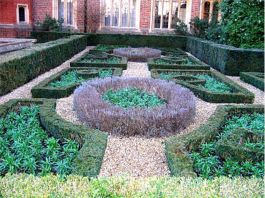
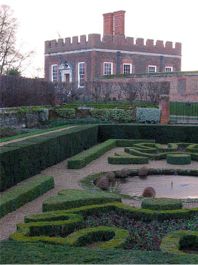
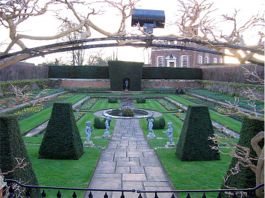
The final guided tour that I took was that of the Queen's State Apartments. Although these were of course meant to be the State Apartments of Queen Mary, she had died before they had been fitted out. Thus the decoration and layout of these apartments is the work of later monarchs. William III died following a riding accident during a hunt in the grounds of Hampton Court palace in 1702. William's sister-in-law Anne took the throne, although she preferred Windsor castle or Kensington Palace to Hampton Court, she did have some outstanding work there completed and attended council meetings there. Alexander Pope's 'rape of the Lock' which was based on a real incident after card play at the Palace, includes a famous couplet (tea then being pronounced as 'tay') :
Here thou, a great Anne, whom three realms obey
Dost sometimes counsel take - and sometimes tea
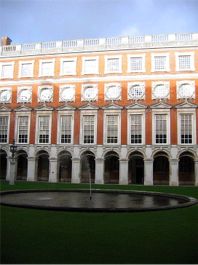 Thus, it was not until the Hanoverians and the accession of King
George I and later George II that work at Hampton Court and further changes to
the interior was made. The Queen's State Apartments were fashioned such that
there were State apartments on the Fountain gardens side and a set of more
intimate Georgian private rooms facing onto Fountain Court. These private
Georgian rooms are a separate and self guided tour from the Sate Apartments.
Thus, it was not until the Hanoverians and the accession of King
George I and later George II that work at Hampton Court and further changes to
the interior was made. The Queen's State Apartments were fashioned such that
there were State apartments on the Fountain gardens side and a set of more
intimate Georgian private rooms facing onto Fountain Court. These private
Georgian rooms are a separate and self guided tour from the Sate Apartments.
Hampton Court was then a favoured summer residence for the Hanoverian Court. During the reign of George I, the Prince of Wales and his wife spent a lavish time at Hampton Court Palace while George I was out of the country visiting his native Hanover. There was no love lost between George I and the Prince of Wales and upon his return in 1718, George I expelled the Prince of Wales and took up residence in private with his two German mistresses. However, in an attempt at not allowing the political favour of his son, George I gave lavish balls and assemblies and even dined in public.
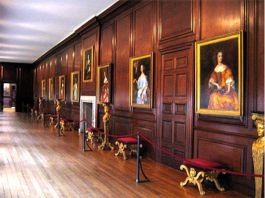
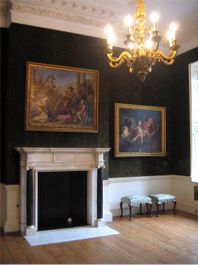
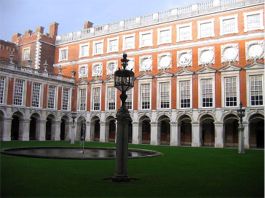
George II and Queen Caroline spent some summers at Hampton Court and had William Kent remodel some of the rooms. A tour through some of these Georgian rooms demonstrate the change to Georgian interior design. There is one particular room, which was a private room used by the Queen and here daughters for entertainment including tea and cards, is most interesting. It houses some fine mid eighteenth century furniture, including a pair of fold over card tables in walnut. Each having candle stands on the corners and guinea wells in which their stake money would be placed during gambling with cards. There is also a table laid with tea equipage, including a handsome silver 'bullet shaped' teapot, salver, tea canisters, sugar nips mote and teaspoons. Also on the side table are two matching cylindrical silver pots, one for coffee, the other for chocolate.
 Having spent an enjoyable day looking round most of the State and
Having spent an enjoyable day looking round most of the State and
Private apartments as well as the extensive gardens and grounds I took my afternoon tea in the Queen Elizabeth I's Privy Kitchen café. However, I later discovered the Tiltyard cafe in the gardens, which in my opinion is a much nicer place to take tea. It is larger, uses teapots, instead of a tea bag floating in large china mug! The surroundings are also more favourable to the other café. The cakes served are very pleasant, I had carrot cake with my 'mug' of tea. On my next visit to the Palace, I will try the Tiltyard cafe!
If you get to visit Hampton Court palace, I hope that you enjoy it, I certainly did. Please allow yourself a full day there if you wish to take advantage of the guided tours as well as to wander the Palace and gardens yourself. Hampton Court Palace and Gardens are also open through out the winter, so an ideal place to visit to shake off the winter blues and a good time to visit as it may not be so busy then.
Hampton Court Palace Surrey KT8 9AU Tel: 0870 751 5175 or for recorded information telephone: 0870 752 7777 For a local map: click here Map courtesy of www.streetmap.co.ukTo review past newsletters, just follow this link:
Past newsletters.
To subscribe to this free newsletter -
Click here